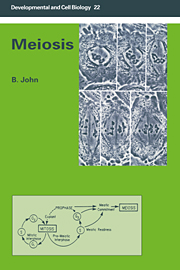Book contents
- Frontmatter
- Contents
- Acknowledgements
- Prologue
- 1 Introduction – multiplication and division
- 2 Modes of meiosis
- 3 Occurrence and timing of meiosis
- 4 Events and mechanisms of meiosis
- 5 Chromosome disjunction
- 6 The genetic control of meiosis
- 7 Sequences and consequences of meiosis
- 8 Evolutionary aspects of meiosis
- Postlogue
- References
- Index
Prologue
Published online by Cambridge University Press: 21 January 2010
- Frontmatter
- Contents
- Acknowledgements
- Prologue
- 1 Introduction – multiplication and division
- 2 Modes of meiosis
- 3 Occurrence and timing of meiosis
- 4 Events and mechanisms of meiosis
- 5 Chromosome disjunction
- 6 The genetic control of meiosis
- 7 Sequences and consequences of meiosis
- 8 Evolutionary aspects of meiosis
- Postlogue
- References
- Index
Summary
Meiosis is a method of nuclear division leading to an orderly reduction of the chromosome number. It is coextensive with sexual reproduction and in the sexual cycle it compensates for fertilization. These statements provide us with a minimum definition of the process.
Cyril DarlingtonEvery living eukaryote either is, or at some time has been, a single cell. New cells arise only by the division of existing cells and this involves the division of both nucleus and cytoplasm. In eukaryotes nuclei divide in only two ways, by mitosis or by meiosis. Meiosis represents a unique form of cellular differentiation and, unlike mitosis, is most usually initiated only once in the life cycle of a eukaryote. Moreover, while mitosis is associated with uniparental, asexual, systems, it is meiosis that has made sex and biparental inheritance possible. It is then a unique and distinctive event in the life of an organism.
It is also a meticulously exact event normally involving both an accurate quantitative reduction in chromosome number, on the one hand, and aprecise partitioning of genetic material, on the other hand. Meiosis thus fulfills two interrelated functions both of which are connected with the process of sexual reproduction. It ensure the production of a haploidphase in the life cycle of an organism (reduction) and, in one form or another, provides for the production of genetically distinct offspring (recombination). Deviations from this strict schedule of behaviour are, with few exceptions, eventually either lethal or sublethal since a precisely structured chromosome complement is an essential prerequisite for basic cell function during development.
Because meiosis is such a highly ordered process, the essential genes and proteins that control it can be reasonably anticipated to show considerable conservation throughout eukaryotes.
- Type
- Chapter
- Information
- Meiosis , pp. xi - xiiPublisher: Cambridge University PressPrint publication year: 1990



